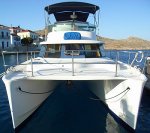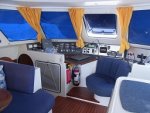Irish Rover
Well-known member
Hi,
I have zero experience on catamarans and I've recently bought a motor cat which I'm going to collect from Greece in early April. When I say zero experience I mean I'd never been on a cat until a couple of months ago when I did a 15 minute jaunt around Lefkas harbour on the boat I eventually ended up buying and I haven't been on one since or even seen my own boat since. I'm obviously going to have to learn a lot "on the job" as I plan to collect the boat and sail from Preveza to Kusadasi in early April. I've had a number of different boats over the last 20 years but all were mono-hull single engine motorboats so twin engines and twin hulls are new to me and I don't mind saying I'm more than a little apprehensive. So I'd love to hear from anyone who can offer any advice.
One of the things which will be new to me is having to use an anchor bridle and I imagine with a bit of practice I'll get used to it. Immediately however for the trip home I'm going to have to figure out what to do when med mooring without the benefit of lazy lines. How do you judge when to attach the bridle as you go stern to in a harbour?
As I found out on a couple of other threads posters on here are very generous with information and advice and also very patient and indulgent when dealing with stupid questions from virtual rookies. So here I am again asking for help.
I have zero experience on catamarans and I've recently bought a motor cat which I'm going to collect from Greece in early April. When I say zero experience I mean I'd never been on a cat until a couple of months ago when I did a 15 minute jaunt around Lefkas harbour on the boat I eventually ended up buying and I haven't been on one since or even seen my own boat since. I'm obviously going to have to learn a lot "on the job" as I plan to collect the boat and sail from Preveza to Kusadasi in early April. I've had a number of different boats over the last 20 years but all were mono-hull single engine motorboats so twin engines and twin hulls are new to me and I don't mind saying I'm more than a little apprehensive. So I'd love to hear from anyone who can offer any advice.
One of the things which will be new to me is having to use an anchor bridle and I imagine with a bit of practice I'll get used to it. Immediately however for the trip home I'm going to have to figure out what to do when med mooring without the benefit of lazy lines. How do you judge when to attach the bridle as you go stern to in a harbour?
As I found out on a couple of other threads posters on here are very generous with information and advice and also very patient and indulgent when dealing with stupid questions from virtual rookies. So here I am again asking for help.



